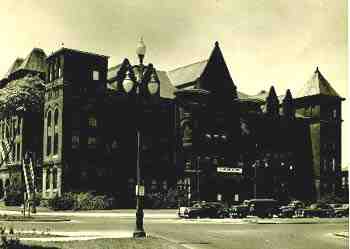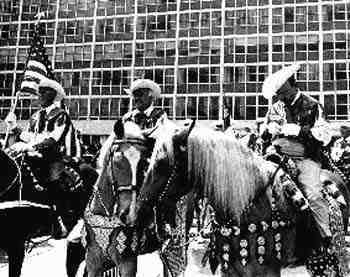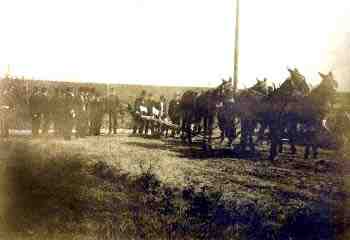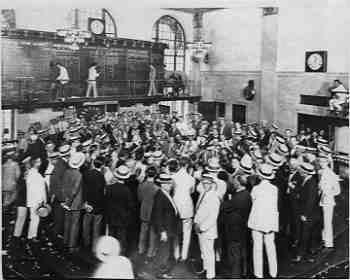

 | 
|
| The cornerstone of the Orleans Parish Criminal Court and the Jail behind it was laid on February 4, 1893 at the corner of Tulane Avenue and Saratoga Street (now Loyola Avenue). Sixty-three years later, on November 30, 1956, a ground breaking ceremony took place at the same spot--for the Main Branch of the New Orleans Public Library. The o ld courthouse had been replaced in 1931 by the new facility at Tulane and Broad and was subsequently used as the city's Municipal Courts, as the First District Police Station, and, in the late thirties, as offices for the WPA and the NYA. The building was finally torn down in 1949, and the space stood vacant until NOPL made the corner its home. (Rumors that the ghosts of prisoners from the old jail still haunt the Library's sub-basement have never been substantiated.) [Louisiana Photograph Collection. Municipal Government Collection] | The Prytania Market stood on the River side of Prytania Street at the corner of Upperline. From its earliest days, the city operated public fish, vegetable, and meat markets situated in neighborhoods throughout town. City ordinances regulated stall rental, the products that could or could not be sold at certain markets or times of the year (before refrigeration, for example, the sale of shrimp, fish, or crabs, was prohibited between May 1 and October 1) and enforced very specific health and sanitary regulations. The advent of supermarkets in the 1950s brought an end to the era of the public market, and today, only the French Market remains under municipal ownership, more a tourist attraction now than a viable market. Some of the old market buildings have survived, however, restored to new uses as offices or shops. The site of the Prytania Market is now home to a small public park. [Louisiana Photograph Collection. Municipal Government Collection; Department of Property Management Series] |
 | 
|
| Mayor Victor Schiro, dressed up for his role as head honcho of the "Mayor's Posse," which paraded on horseback in full cowboy regalia at Mardi Gras. Mayor Schiro's successors in office have not perpetuated this rather odd sight of the city's highest public official dressed up like Roy Rogers, but Jefferson Parish's Sheriff Harry Lee has adopted the tradition. [Louisiana Photograph Collection. Victor H. Schiro Collection] | Mayor Martin Behrman breaks ground for Behrman Street (now Behrman Avenue) at the West boundary of the U.S. Naval Station in Algiers, 1906. The small town of Algiers, which Behrman called home, burgeoned after the completion of the Mississippi River Bridge and is today home to some 57,000 New Orleanians. Methods of road construction have also changed considerably since Behrman's day! [Louisiana Photograph Collection. Martin Behrman Collection] |
| One manager of the 1854 masquerade ball represented by this ticket was H.M. Isaacson who
later became captain of the Rex organization. Does the fact that they were holding a masquerade
ball on a Saturday evening during Lent suggest that the American founders of the "modern Mardi
Gras" were thinking about something other than the religious symbolism of the annual celebration?
[Rare Vertical File: Tickets]
|
 | 
|
| In the New Orleans of 1914, one did not have to leave the city limits in order to enjoy an automobile drive in the country! This was the route to the Mississippi Gulf Coast prior to construction of the Watson-Williams bridge across eastern Lake Pontchartrain in 1928 and of the Chef Menteur and Rigolets bridges a few years later. [Louisiana Postcard Collection: New Orleans Streets] | The Lane Mills on Tchoupitoulas Street just upriver from Napoleon Avenue reminds us of the important role that the cotton industry once played within the city's economic framework. The mills closed in the late 1950s but the section closest to Napoleon remains an integral part of the New Orleans economy. Through an outstanding example of adaptive reuse, the structure now houses a key link in the Schwegmann's supermarket chain. Schwegmann's is the fifth largest private sector employer in the New Orleans area (or at least it was until the business was sold to outside interests recently). [Rare Vertical File: Letterheads--Twentieth Century Business Firms] |
| New Orleans today is the major Democratic Party stronghold in a state that is becoming
increasingly Republican. This ballot from the 1888 election recalls the unsuccessful effort by a
former Republican governor to return to the statehouse. The presence of such stalwart Democrats
as future congressman Robert C. Davey and General G. T. Beauregard on the Republican ticket does
not mean that they were making the same party switch that Billy Tauzin, Buddy Roemer, and
Mike Foster made in more recent times. [Rare Vertical File: Ballots]
|
 | 
|
| NOPSI inaugurated electric bus service on December 3, 1929, when two of these electric trolley buses began to roll on the "Southport Shuttle Route" from Oak Street to Carrollton Avenue Electric buses continued in use throughout the city into the 1970s, replacing a number of the old neighborhood streetcar lines. Also visible in this photograph is the Mater Dolorosa School, seen at the left of the Church; once filled with grammar school children, the building has been converted by the Archdiocese of New Orleans into apartments for senior citizens. [Louisiana Photograph Collection. Municipal Government Collection; Department of Utilities Series] | The trading floor of the New Orleans Cotton Exchange, 1924. The Cotton Exchange was established in 1871 by a group of local factors to regulate and standardize the cotton trade in New Orleans. This photograph reminds us that during the 19th century and into the 20th cotton was king in New Orleans, the driving force behind the city's economy. In the mid-1960s, however, trading in cotton futures had declined and new federal regulations governing cotton trading led to the closure of the Exchange. [Louisiana Photograph Collection. New Orleans Cotton Exchange Collection] |
Return to Beginning of Exhibit